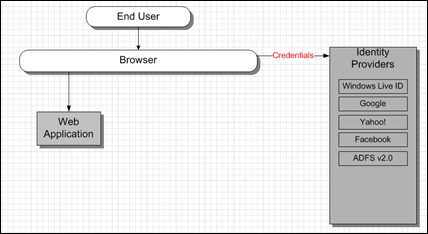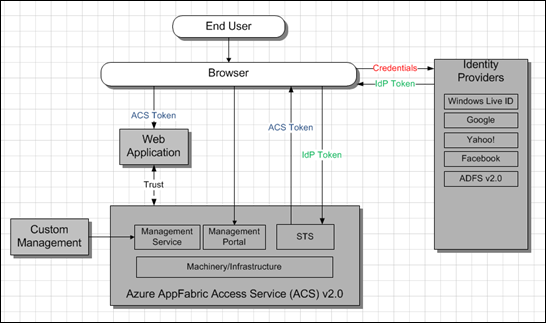Integrating ASP.NET Web Applications With Azure AppFabric Access Control Service (ACS) – Scenario and Solution
Azure AppFabric Access Control Service (ACS) v2 allows integrating Internet authentication mechanisms, such as Windows Live ID, Google, Yahoo!, Facebook, and enterprise identity management systems such as AD via ADFS. It is done based on open protocols such as WS-Trust, WS-Federation, OAuth, OpenID and tokens such as SAML and SWT. This authentication externalization is called federation.
This post answers the following question:
How can I externalize authentication for my ASP.NET Web Application?
Scenario

Solution

Solution Summary
Architecture |
Explained
|
Federation |
How-to’s |
Authentication |
How-to’s
|
Authorization |
Explained How-to’s |
Identity/Token flow and transformation |
How-to’s
|
Trust management |
How-to’s
|
Related Books
- Programming Windows Identity Foundation (Dev - Pro)
- A Guide to Claims-Based Identity and Access Control (Patterns & Practices) – free online version
- Developing More-Secure Microsoft ASP.NET 2.0 Applications (Pro Developer)
- Ultra-Fast ASP.NET: Build Ultra-Fast and Ultra-Scalable web sites using ASP.NET and SQL Server
- Advanced .NET Debugging
- Debugging Microsoft .NET 2.0 Applications
Related Info
- Azure AppFabric Access Control Service (ACS) v 2.0 High Level Architecture – Web Application
- Windows Identity Foundation (WIF) Explained – Web Browser Sign-In Flow (WS-Federation Passive Requestor Profile)
- SSO, Identity Flow, Authorization In Cloud Applications and Services – Challenges and Solution Approaches
- Protocols Supported By Windows Identity Foundation (WIF)
- Windows Identity Foundation (WIF) Fast Track
- Windows Identity Foundation (WIF) Code Samples
- Windows Identity Foundation (WIF) SDK Help Overhaul
- Windows Identity Foundation (WIF) and Azure AppFabric Access Control (ACS) Service Survival Guide